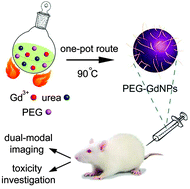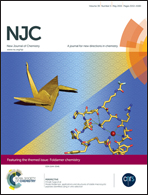One-pot and facile synthesis of anti-biofouling polymer-modified gadolinium-based nanoprobes for dual-modal imaging and long-lasting tracking†
Abstract
Multi-modal imaging in tissue and animals has integrated the advantages of individual molecular imaging modalities and shown great potential in both pre-clinical and clinical fields. In the present work, a high-performance nanoparticulate contrast agent based on PEGylated gadolinium hydroxycarbonate nanoparticles (PEG-GdNPs) was designed and synthesized via a facile approach. Due to the outstanding X-ray absorption coefficient/K-edge value and the presence of unpaired 4f electrons of element Gd, our well-prepared nanoprobes were successfully used as dual-modal contrast agents for in vivo synergistic magnetic resonance and X-ray computed tomography imaging. Bio-distribution of the nanoparticles was further studied via in vivo long-term tracking during the imaging process, revealing that most of the nanoprobes could accumulate in the liver and therefore act as a liver-targeted imaging agent. Moreover, toxicity including cell viability, blood biochemical assay, as well as changes in body weight and histology indicated the low systemic toxicity of our nanoprobes. Taken together, we believe that PEG-GdNPs with their excellent imaging capability and high biocompatibility may find widespread application in the field of biomedicine.


 Please wait while we load your content...
Please wait while we load your content...